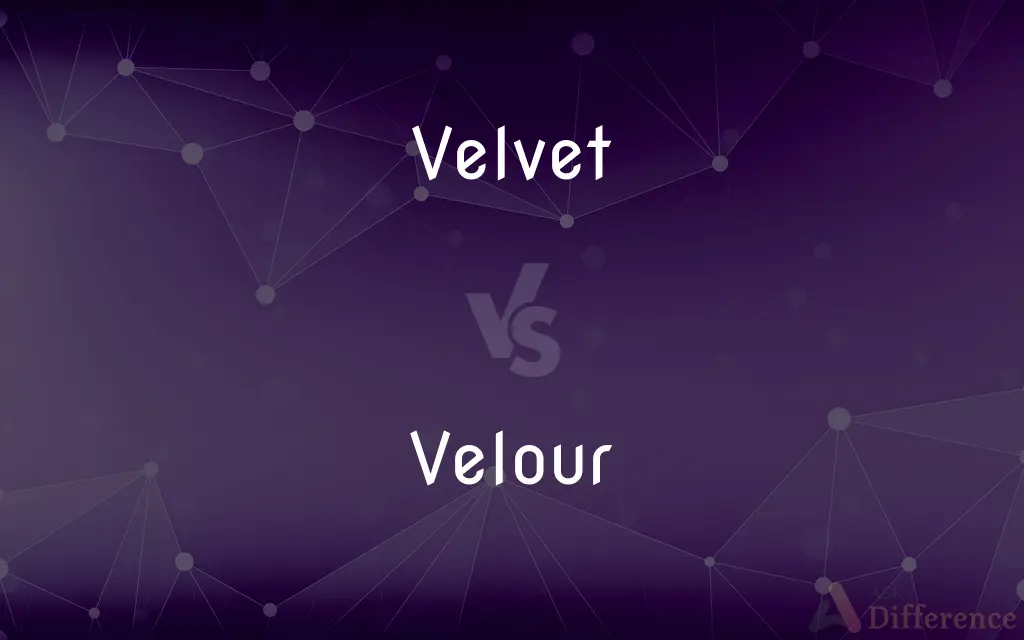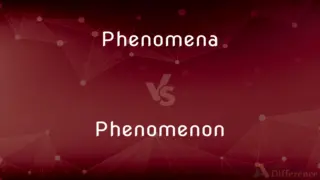Velvet vs. Velour — What's the Difference?
By Tayyaba Rehman — Updated on November 4, 2023
Velvet is a closely woven fabric with a thick short pile, while velour is a knit, typically made from cotton or synthetics, with a cut pile.

Difference Between Velvet and Velour
Table of Contents
ADVERTISEMENT
Key Differences
Velvet is a woven, tufted fabric in which the cut threads are evenly distributed, with a short dense pile, giving it a distinctive soft feel. Velour, by contrast, is a knit fabric, usually made from cotton or polyester, with a similar feel but less formal look.
The rich appearance of velvet is often associated with nobility, and it has been used for centuries in clothing and upholstery. Velour, while also plush and soft, has a more casual appearance and is often used in tracksuits and everyday clothing.
Velvet is historically made from silk, making it more luxurious and expensive; however, modern velvet can also be made from synthetic materials like polyester. Velour is typically less expensive, as it is commonly made from cotton or synthetic materials, and is more stretchy and comfortable due to its knit structure.
When it comes to care, velvet requires special attention to maintain its pile and luxurious texture, often necessitating dry cleaning, while velour can often be machine washed and is more durable and easy to maintain, making it a popular choice for activewear.
Despite their differences, both velvet and velour bring a sense of texture and depth to fashion and decor, with velvet being preferred for formal and high-end applications, and velour for comfort and ease of use.
ADVERTISEMENT
Comparison Chart
Texture
Woven with a short, dense pile
Knitted with a cut pile
Material
Traditionally silk, now also synthetic
Usually cotton or synthetic
Appearance
Luxurious, rich sheen
Casual, matte finish
Care
Typically requires dry cleaning
Often machine washable
Use
Formal wear, upholstery
Casual wear, comfort clothing
Compare with Definitions
Velvet
Silky Pile
He chose a velvet blazer for the formal event.
Velour
Casual Appearance
The velour seat covers made the car interior cozy.
Velvet
Luxurious Fabric
She wore a gown made of deep blue velvet.
Velour
Knit Fabric
His favorite velour tracksuit was both comfortable and stylish.
Velvet
Woven Texture
The velvet curtains added a touch of elegance to the room.
Velour
Stretchy Material
The velour leggings allowed for a full range of motion.
Velvet
Velvet is a type of woven tufted fabric in which the cut threads are evenly distributed, with a short dense pile, giving it a distinctive soft feel. By extension, the word velvety means "smooth like velvet".
Velour
Comfort Textile
A velour hoodie is perfect for a relaxed day at home.
Velvet
A closely woven fabric of silk, cotton, or nylon, that has a thick short pile on one side
An armchair covered in velvet
Red velvet curtains
Velour
Cotton Blend
She preferred the velour towel for its plushness.
Velvet
A soft fabric having a smooth, dense pile and a plain underside.
Velour
Velour or velours is a plush, knitted fabric or textile similar to velvet or velveteen. It is usually made from cotton, but can also be made from synthetic materials such as polyester.
Velvet
Something suggesting the smooth surface of velvet.
Velour
A closely napped fabric resembling velvet, used chiefly for clothing and upholstery.
Velvet
Smoothness; softness.
Velour
A felt resembling velvet, used in making hats.
Velvet
The soft, furry covering on the developing antlers of deer.
Velour
A knit fabric similar to velvet, but usually somewhat coarser.
Velvet
The winnings of a gambler.
Velour
Heavy fabric that resembles velvet
Velvet
A profit or gain beyond what is expected or due.
Velvet
New England See milkshake.
Velvet
A closely woven fabric (originally of silk, now also of cotton or man-made fibres) with a thick short pile on one side.
Velvet
Very fine fur, including the skin and fur on a deer's antlers.
Velvet
A female chinchilla; a sow.
Velvet
The drug dextromethorphan.
Velvet
Money acquired by gambling.
Velvet
To cover with velvet or with a covering of a similar texture.
Velvet
(cooking) To coat raw meat in starch, then in oil, preparatory to frying.
Velvet
To remove the velvet from a deer's antlers.
Velvet
To soften; to mitigate.
Velvet
(of a cat's claws) to retract.
Velvet
Made of velvet.
Velvet
Soft and delicate, like velvet; velvety.
Velvet
(politics) peaceful, carried out without violence; especially as pertaining to the peaceful breakup of Czechoslovakia.
Velvet
A silk fabric, having a short, close nap of erect threads. Inferior qualities are made with a silk pile on a cotton or linen back, or with other soft fibers such as nylon, acetate, or rayon.
Velvet
The soft and highly vascular deciduous skin which envelops and nourishes the antlers of deer during their rapid growth.
Velvet
Something likened to velvet{1} in being soft or luxurious; as, a lawn of velvet.
Velvet
Made of velvet; soft and delicate, like velvet; velvety.
Velvet
To pain velvet.
Velvet
To make like, or cover with, velvet.
Velvet
A silky densely piled fabric with a plain back
Velvet
Smooth and soft to sight or hearing or touch or taste
Velvet
Resembling velvet in having a smooth soft surface
Velvet
Rich Sheen
The velvet upholstery looked regal in the dim light.
Velvet
Soft Surface
Her velvet scarf was soft against her skin.
Common Curiosities
Can you machine wash velour?
Yes, most velour items can be machine washed on a gentle cycle.
Is velvet a good choice for everyday wear?
Velvet can be delicate and is often reserved for special occasions.
How do you clean velvet?
Velvet often requires dry cleaning, especially if it's made of silk or rayon.
What is velvet commonly used for?
Velvet is used for formal wear, upholstery, and curtains.
Is velour considered a luxury material?
Velour is more casual and not typically considered luxury, unlike velvet.
Is velvet difficult to maintain?
Yes, velvet requires careful maintenance to preserve its texture.
What is velour commonly used for?
Velour is commonly used for casual clothing and comfort-focused items.
Does velvet stretch?
Woven velvet has minimal stretch, unlike stretch velvet varieties.
Are velvet and velour vegan-friendly?
Synthetic versions are vegan-friendly, while silk velvet is not.
Can I iron velvet?
Ironing velvet can crush its pile; it's better to steam it.
Can I iron velour?
Velour can be ironed on a low setting with care.
What makes velvet shine?
The cut pile and type of fabric give velvet its characteristic shine.
Does velour stretch?
Yes, velour can stretch due to its knit structure.
What seasons are appropriate for velvet and velour?
Velvet is often worn in cooler seasons, while velour can be year-round.
Is velour shiny?
Velour typically has a matte finish and lacks the shine of velvet.
Share Your Discovery

Previous Comparison
Phenomena vs. Phenomenon
Next Comparison
Pops vs. DadAuthor Spotlight
Written by
Tayyaba RehmanTayyaba Rehman is a distinguished writer, currently serving as a primary contributor to askdifference.com. As a researcher in semantics and etymology, Tayyaba's passion for the complexity of languages and their distinctions has found a perfect home on the platform. Tayyaba delves into the intricacies of language, distinguishing between commonly confused words and phrases, thereby providing clarity for readers worldwide.














































